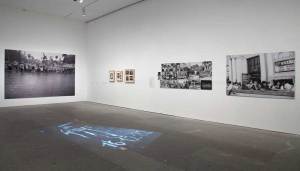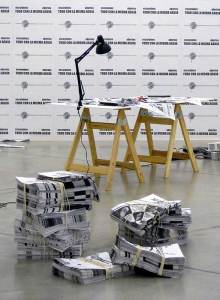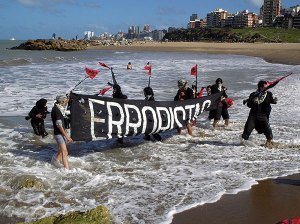As Argentina defaulted on its debt this summer at the end of July, two complementary exhibitions in Buenos Aires provided resonant explorations of economic precariousness and social protest in Latin American art. ‘Perder la Forma Humana’ (Losing the Human Form) at the Centre for Contemporary Art, Museo de la Universidad Nacional de Tres de Febrero (MUNTREF), took a long view, bringing together works from across Latin America during the 1970s and 1980s that register resistance against repressive political situations.
‘Acción Urgente’ (Urgent Action), meanwhile, at Fundación Proa, focused on contemporary creative dissent by a range of artistic collectives working in the southern cone – in the case of Argentina, often responding to the crippling 2001 crash that led to the recent default, signalling the interlinked and on-going politics of previous crises. Taken together, the two shows offered a rich compendium of works from the 1970s through to the current moment that, while responding to a variety of situations, are often linked by inventiveness and anger in equal measure.

Installation view , ‘Perder la forma humana’ at the Reina Sofía, Madrid. Photo: Joaquín Cortés
Both were the result of extensive research by their respective curators: ‘Perder la Forma Humana’, which was previously shown at the Reina Sofía museum in Madrid during 2012–13, formed part of the Conceptualismos del Sur research network, which has resulted in several exhibitions and publications addressing the links between conceptual art and politics in Latin America. ‘Acción Urgente’, meanwhile, situated recent manifestations – such as the extensive student protests that took place in Chile between 2011 and 2013 – within the wider lineage of socially engaged art addressed by ‘Perder la Forma Humana’.
The visceral aspect of these practices was perhaps most evident in ‘Perder la Forma Humana’, exemplified by La Conquista de America (1989) by the Chilean artists Pedro Lemebel and Francisco Casas (Las Yeguas del Apocalipsis). The artists performed a Chilean national dance called the ‘cuenca’ across a map of Latin America outlined on the floor, scattered with shards of broken Coca-Cola bottles. During the Pinochet regime, women danced the ‘cuenca’ alone, subversively drawing attention to missing children and partners detained by the military. While a deeply affective critique of the political situation, this bloodied performance of the ‘cuenca’ by two men also resonated specifically with the regime’s discrimination against homosexuality, and on a transnational level with the AIDS crisis.

Instalación documental (2003–2010) (2014), © Mujeres Públicas
La Conquista de America, by invoking the popular protest of dancing alone, addressed bodily absence – a concern shared by the Argentinean artist León Ferrari’s Nosotros no Sabiamos (We Didn’t Know). In 1976, the year in which a military regime took control in Argentina until 1983, Ferrari began to collect newspaper articles relating to the bodies that had started appearing in the Rio de la Plata. During his subsequent exile in Brazil, Ferrari gathered this material together to create a documentary work intended to counteract attempts by certain parts of Argentinean society to turn a blind eye to the disappearances and torture during the regime, while forming an ephemeral monument to many lost lives.
Yet rather than individual works, the overwhelming impression from both exhibitions was of networks of activity between people, often operating collaboratively, and resulting in playful, witty social interventions. This was particularly the case in ‘Acción Urgente’, which featured stacks of posters and protest literature by the Argentinean collective Mujeres Públicas, who have agitated for women’s rights since 2003. Their Oracion por el Aborto, for example, is a mass-produced little prayer card featuring a simpering Virgin Mary on one side, and an oration for women to have the right to chose on the other.

OPERACIÓN B.A.N.G. (2005) © Archivo Etcétera
This sense of irreverence recurred throughout ‘Acción Urgente’, exemplified by the rubbish bags distributed to the public by Peru’s Colectivo Sociedad Civil in 2000, printed with the faces of politicians then embroiled in electoral fraud together with the legend ‘put the rubbish into the rubbish.’ The performances and protests staged by Grupo Etcétera, also from Argentina, are characterised by a similarly Dadaesque irreverence, notably the series of street actions developed around their tongue-in-cheek International Errorista Manifesto, which asserts the pre-eminence of mistakes and errors.
During the 2001 economic crisis, Etcétera staged El Mierdazo (literally, shit-in) protest outside the Argentinean National Congress, which, as its name suggests, invited people to express their anger towards the government in a particularly elemental way. There has yet to be a recurrence in 2014, but both ‘Acción Urgente’ and ‘Perder la Forma Humana’ both provided an ultimately uplifting, while also deeply moving, survey of creative socio-political engagement with a finely attuned sense of the ridiculous. Many of the materials on display here may still come in handy as tools for direct action, as much as historical documents.
‘Perder la Forma Human’ was at the Centre for Contemporary Art, Museo de la Universidad Nacional de Tres de Febrero (MUNTREF), Buenos Aires, from 20 May–10 August.
‘Acción Urgente’ was at the Fundación Proa, Buenos Aires, from 5 July–31 August.
Related Articles
Review: ‘Disobedient Objects’ at the V&A (Annabel Sheen)
Review: ‘Radical Geometry’, South American art at the Royal Academy, London (Catherine Spencer)

Art and protest in Latin America
OPERACIÓN B.A.N.G. Desembarco errorista en la Cumbre de las Américas. Mar del Plata (Errorist landing at the Summit of the Americas) (2005) © Archivo Etcétera
Share
As Argentina defaulted on its debt this summer at the end of July, two complementary exhibitions in Buenos Aires provided resonant explorations of economic precariousness and social protest in Latin American art. ‘Perder la Forma Humana’ (Losing the Human Form) at the Centre for Contemporary Art, Museo de la Universidad Nacional de Tres de Febrero (MUNTREF), took a long view, bringing together works from across Latin America during the 1970s and 1980s that register resistance against repressive political situations.
‘Acción Urgente’ (Urgent Action), meanwhile, at Fundación Proa, focused on contemporary creative dissent by a range of artistic collectives working in the southern cone – in the case of Argentina, often responding to the crippling 2001 crash that led to the recent default, signalling the interlinked and on-going politics of previous crises. Taken together, the two shows offered a rich compendium of works from the 1970s through to the current moment that, while responding to a variety of situations, are often linked by inventiveness and anger in equal measure.
Installation view , ‘Perder la forma humana’ at the Reina Sofía, Madrid. Photo: Joaquín Cortés
Both were the result of extensive research by their respective curators: ‘Perder la Forma Humana’, which was previously shown at the Reina Sofía museum in Madrid during 2012–13, formed part of the Conceptualismos del Sur research network, which has resulted in several exhibitions and publications addressing the links between conceptual art and politics in Latin America. ‘Acción Urgente’, meanwhile, situated recent manifestations – such as the extensive student protests that took place in Chile between 2011 and 2013 – within the wider lineage of socially engaged art addressed by ‘Perder la Forma Humana’.
The visceral aspect of these practices was perhaps most evident in ‘Perder la Forma Humana’, exemplified by La Conquista de America (1989) by the Chilean artists Pedro Lemebel and Francisco Casas (Las Yeguas del Apocalipsis). The artists performed a Chilean national dance called the ‘cuenca’ across a map of Latin America outlined on the floor, scattered with shards of broken Coca-Cola bottles. During the Pinochet regime, women danced the ‘cuenca’ alone, subversively drawing attention to missing children and partners detained by the military. While a deeply affective critique of the political situation, this bloodied performance of the ‘cuenca’ by two men also resonated specifically with the regime’s discrimination against homosexuality, and on a transnational level with the AIDS crisis.
Instalación documental (2003–2010) (2014), © Mujeres Públicas
La Conquista de America, by invoking the popular protest of dancing alone, addressed bodily absence – a concern shared by the Argentinean artist León Ferrari’s Nosotros no Sabiamos (We Didn’t Know). In 1976, the year in which a military regime took control in Argentina until 1983, Ferrari began to collect newspaper articles relating to the bodies that had started appearing in the Rio de la Plata. During his subsequent exile in Brazil, Ferrari gathered this material together to create a documentary work intended to counteract attempts by certain parts of Argentinean society to turn a blind eye to the disappearances and torture during the regime, while forming an ephemeral monument to many lost lives.
Yet rather than individual works, the overwhelming impression from both exhibitions was of networks of activity between people, often operating collaboratively, and resulting in playful, witty social interventions. This was particularly the case in ‘Acción Urgente’, which featured stacks of posters and protest literature by the Argentinean collective Mujeres Públicas, who have agitated for women’s rights since 2003. Their Oracion por el Aborto, for example, is a mass-produced little prayer card featuring a simpering Virgin Mary on one side, and an oration for women to have the right to chose on the other.
OPERACIÓN B.A.N.G. (2005) © Archivo Etcétera
This sense of irreverence recurred throughout ‘Acción Urgente’, exemplified by the rubbish bags distributed to the public by Peru’s Colectivo Sociedad Civil in 2000, printed with the faces of politicians then embroiled in electoral fraud together with the legend ‘put the rubbish into the rubbish.’ The performances and protests staged by Grupo Etcétera, also from Argentina, are characterised by a similarly Dadaesque irreverence, notably the series of street actions developed around their tongue-in-cheek International Errorista Manifesto, which asserts the pre-eminence of mistakes and errors.
During the 2001 economic crisis, Etcétera staged El Mierdazo (literally, shit-in) protest outside the Argentinean National Congress, which, as its name suggests, invited people to express their anger towards the government in a particularly elemental way. There has yet to be a recurrence in 2014, but both ‘Acción Urgente’ and ‘Perder la Forma Humana’ both provided an ultimately uplifting, while also deeply moving, survey of creative socio-political engagement with a finely attuned sense of the ridiculous. Many of the materials on display here may still come in handy as tools for direct action, as much as historical documents.
‘Perder la Forma Human’ was at the Centre for Contemporary Art, Museo de la Universidad Nacional de Tres de Febrero (MUNTREF), Buenos Aires, from 20 May–10 August.
‘Acción Urgente’ was at the Fundación Proa, Buenos Aires, from 5 July–31 August.
Related Articles
Review: ‘Disobedient Objects’ at the V&A (Annabel Sheen)
Review: ‘Radical Geometry’, South American art at the Royal Academy, London (Catherine Spencer)
Unlimited access from just $16 every 3 months
Subscribe to get unlimited and exclusive access to the top art stories, interviews and exhibition reviews.
Share
Recommended for you
Review: ‘Radical Geometry’, South American art at the Royal Academy, London
The diversity of South American abstraction is one of its main strengths
Wp Wp Wp: Fiona Banner at the Yorkshire Sculpture Park
Fiona Banner’s extraordinary indoor Chinook will make you want duck and run
Among the poppies: volunteering at the Tower of London’s war memorial
Paul Cummins’ red field of poppies has been planted by volunteers, and is still growing